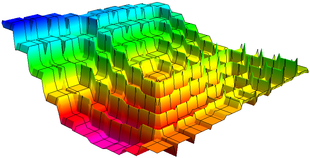10-327/Classnotes for Thursday September 30: Difference between revisions
No edit summary |
No edit summary |
||
| (2 intermediate revisions by 2 users not shown) | |||
| Line 1: | Line 1: | ||
{{10-327/Navigation}} |
{{10-327/Navigation}} |
||
Some blackboard shots are at {{BBS Link|10_327-100930-143624.jpg}}. |
|||
{{Template:10-327:Dror/Students Divider}} |
{{Template:10-327:Dror/Students Divider}} |
||
| Line 14: | Line 16: | ||
[http://katlas.math.toronto.edu/drorbn/images/f/f3/10-327-lec06p05.jpg Lecture 6 page 5] |
[http://katlas.math.toronto.edu/drorbn/images/f/f3/10-327-lec06p05.jpg Lecture 6 page 5] |
||
[[User:D|D]] 12:48, 2 October 2010 (EDT) finite Hausdorff space: The only topology satisfying Hausdorff for a finite set A is the discrete topology; for each distinct point x and y in A, {x} and {y} are disjoint. Also, every finite point set in A is closed. We can check that using the discrete metric on A (d(x,y) = 1 if x =/= y, d(x,y) = 0 if x=y), a sequence of points in A can converge to only one point at most. Also note that Hausdorff condition is stronger than T1. |
|||
Discrete topology implies Hausdorrf condition is obvious. The converse we can prove by contradiction so that its much clearer. Suppose the space X is Hausdorff but it does not have discrete topology. So some finite subset A would not be open. A complement is a finite subset of X would not be closed. That cannot happen because Hausdorff condition implies T1 so that any finite union of singleton set should still be closed. Contradiction here. -Kai [[User:Xwbdsb|Xwbdsb]] 13:31, 4 October 2010 (EDT) |
|||
Latest revision as of 12:31, 4 October 2010
| ||||||||||||||||||||||||||||||||||||||||||||||||||||||||||||
Some blackboard shots are at BBS/10_327-100930-143624.jpg.
| Dror's notes above / Student's notes below |
Here are some lecture notes..
D 12:48, 2 October 2010 (EDT) finite Hausdorff space: The only topology satisfying Hausdorff for a finite set A is the discrete topology; for each distinct point x and y in A, {x} and {y} are disjoint. Also, every finite point set in A is closed. We can check that using the discrete metric on A (d(x,y) = 1 if x =/= y, d(x,y) = 0 if x=y), a sequence of points in A can converge to only one point at most. Also note that Hausdorff condition is stronger than T1.
Discrete topology implies Hausdorrf condition is obvious. The converse we can prove by contradiction so that its much clearer. Suppose the space X is Hausdorff but it does not have discrete topology. So some finite subset A would not be open. A complement is a finite subset of X would not be closed. That cannot happen because Hausdorff condition implies T1 so that any finite union of singleton set should still be closed. Contradiction here. -Kai Xwbdsb 13:31, 4 October 2010 (EDT)

![{\displaystyle [0,1]}](https://wikimedia.org/api/rest_v1/media/math/render/svg/738f7d23bb2d9642bab520020873cccbef49768d)



